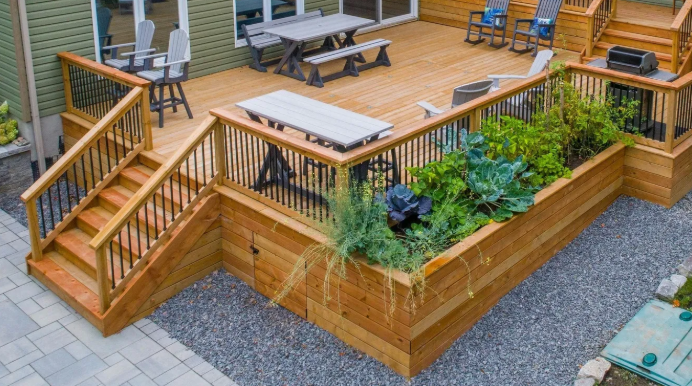A strong deck is very important to a home. But beneath its delightful surface lies a carefully devised framework designed to support burden, resist weather, and guarantee long-term security. Understanding the structural components of a deck helps homeowners appreciate what forms it strong deck and what to expect when building or asserting one.
Whether you’re planning a new build or judging an existing deck, knowing the plants of a strong deck ensures it’s both dependable and built to last.
The Foundation: Deck Footings and Posts
Every deck’s strength starts with its base. The footings and posts distribute the deck’s weight equally to the ground, ensuring security and preventing movement over time.
Footings:
Concrete footings anchor the deck to the soil and hinder shifting along freeze-thaw phases. Properly sized footings based on soil type, deck climax, and local building codes. For maximum establishment, footings should extend beneath the frost line in order to avoid heaving.
Posts:
Vertical posts, usually made from pressure-treated clumsily or metal, link the footings to the frame above. They carry the upright load and must be securely locked with metal supports or post bases to resist liquid and lateral shift. You can contact trusted deck builders for more advice.
Tip: For long-term durability, posts should never sit straightforwardly on concrete; alternatively, use post anchors to elevate them slightly, lowering the risk of rot.
The Support System: Beams and Joists
The beams and joists form the fundamental backbone of the adorn, supporting all surface loads—from chairs and people to planters and railings.
Beams:
Beams run horizontally and endure the load transferred from joists. They’re usually built from double or triple boards of pressure-treated lumber and are frequently supported by posts. Proper beam organization is essential for load distribution—too far separate, and the deck will sag thin.
Joists:
These smaller, evenly divided horizontal boards run perpendicular to the beams and provide direct support for the decking boards above. The Stability Factor: Ledger Board and Fasteners
One of the ultimate critical still often missed components of a deck is the ledger board—the horizontal piece that attaches the deck to the house. If this connection fails, the entire deck construction can collapse.
Railings and Stairs
Railings:
Must meet local code requirements for climax and spacing. Posts should be firmly held to the framing—not just the decking boards—to withstand level pressure. Popular materials contain wood, ore, glass, and composite, each contributing a unique blend of style and durability.
Stairs:
Should have regular riser height and tread insight for safe, wealthy use. Stringers—the structural supports beneath each step—must be properly cut and solidly fastened.
Additional Reinforcements: Flashing, Blocking, and Bracing
To extend your deck’s growth and stability, builders incorporate tinier but vital parts:
Flashing:
Metal or PVC strips placed between the ledger board and the house block moisture from seeping into the home’s foundation. Without flashing, water damage can bring about costly repairs.
Blocking:
Short pieces of lumber are installed between joists to avoid twisting and boost load distribution. They also determine support for railing posts and stairways.
Diagonal Bracing:
Angled boards or metal straps that add rigidity, especially on raised decks. Bracing prevents side-to-side sway produced by wind or movement.
These unseen reinforcements ensure the deck feels solid underfoot and can endure both everyday elements and common use.
Conclusion
An effective deck isn’t just about appearance—it’s about structure, safety, and endurance. From the footings to the posts above, all component plays a vital part in upholding strength and comfort.

